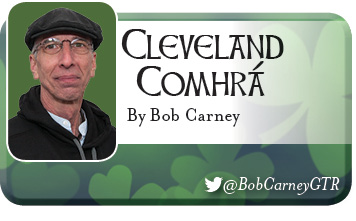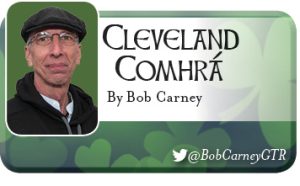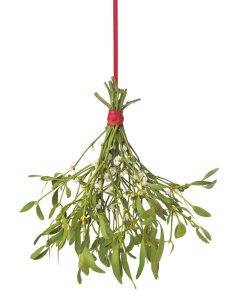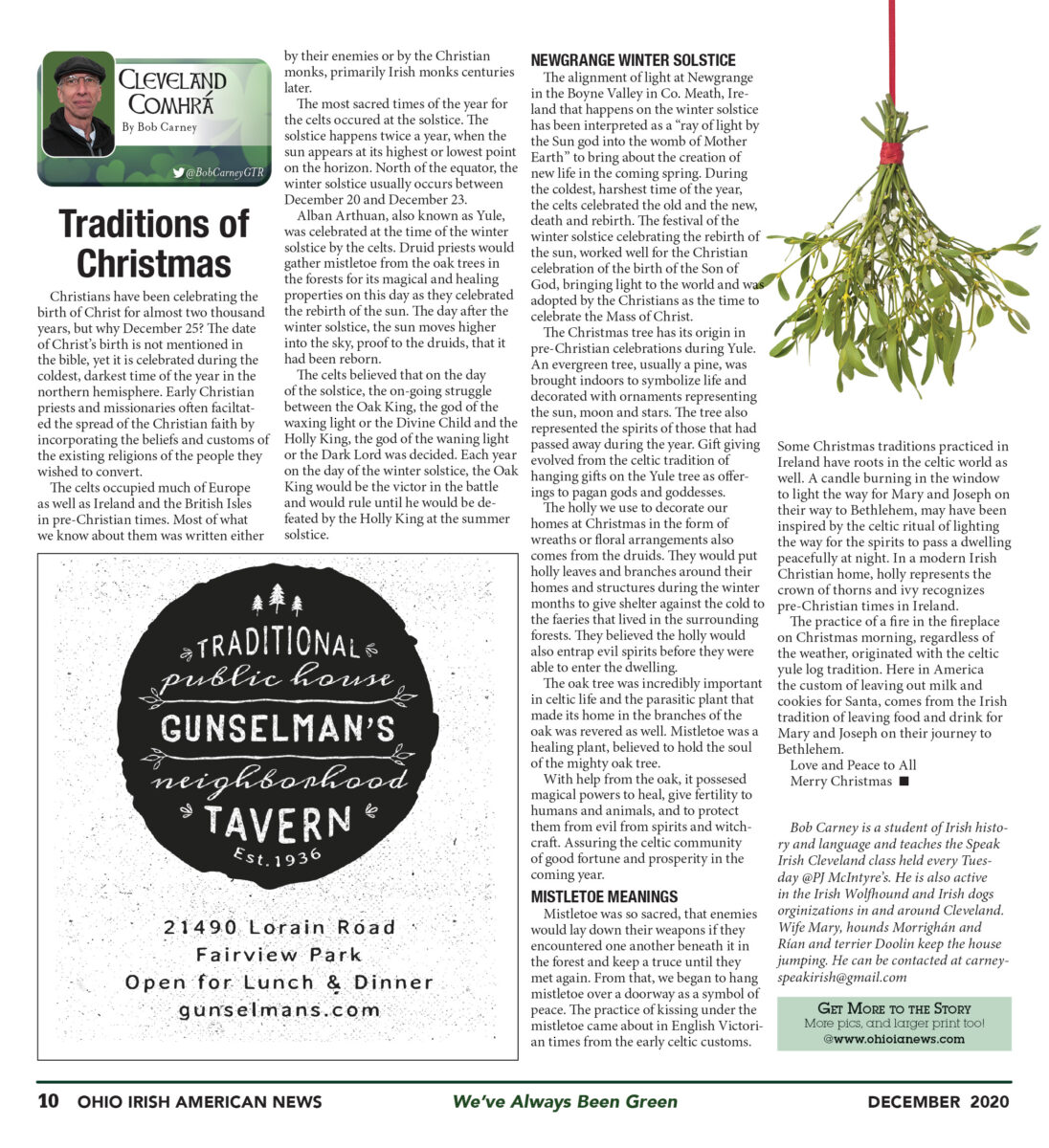
Cleveland Comhrá: Traditions of Christmas
By Bob Carney
Christians have been celebrating the birth of Christ for almost two thousand years, but why December 25? The date of Christ’s birth is not mentioned in the bible, yet it is celebrated during the coldest, darkest time of the year in the northern hemisphere. Early Christian priests and missionaries often faciltated the spread of the Christian faith by incorporating the beliefs and customs of the existing religions of the people they wished to convert.
The celts occupied much of Europe as well as Ireland and the British Isles in pre-Christian times. Most of what we know about them was written either by their enemies or by the Christian monks, primarily Irish monks centuries later.
The most sacred times of the year for the celts occured at the solstice. The solstice happens twice a year, when the sun appears at its highest or lowest point on the horizon. North of the equator, the winter solstice usually occurs between December 20 and December 23.
Alban Arthuan, also known as Yule, was celebrated at the time of the winter solstice by the celts. Druid priests would gather mistletoe from the oak trees in the forests for its magical and healing properties on this day as they celebrated the rebirth of the sun. The day after the winter solstice, the sun moves higher into the sky, proof to the druids, that it had been reborn.
The celts believed that on the day of the solstice, the on-going struggle between the Oak King, the god of the waxing light or the Divine Child and the Holly King, the god of the waning light or the Dark Lord was decided. Each year on the day of the winter solstice, the Oak King would be the victor in the battle and would rule until he would be defeated by the Holly King at the summer solstice.
Newgrange Winter Solstice
The alignment of light at Newgrange in the Boyne Valley in Co. Meath, Ireland that happens on the winter solstice has been interpreted as a “ray of light by the Sun god into the womb of Mother Earth” to bring about the creation of new life in the coming spring. During the coldest, harshest time of the year, the celts celebrated the old and the new, death and rebirth. The festival of the winter solstice celebrating the rebirth of the sun, worked well for the Christian celebration of the birth of the Son of God, bringing light to the world and was adopted by the Christians as the time to celebrate the Mass of Christ.
The Christmas tree has its origin in pre-Christian celebrations during Yule. An evergreen tree, usually a pine, was brought indoors to symbolize life and decorated with ornaments representing the sun, moon and stars. The tree also represented the spirits of those that had passed away during the year. Gift giving evolved from the celtic tradition of hanging gifts on the Yule tree as offerings to pagan gods and goddesses.
The holly we use to decorate our homes at Christmas in the form of wreaths or floral arrangements also comes from the druids. They would put holly leaves and branches around their homes and structures during the winter months to give shelter against the cold to the faeries that lived in the surrounding forests. They believed the holly would also entrap evil spirits before they were able to enter the dwelling.
The oak tree was incredibly important in celtic life and the parasitic plant that made its home in the branches of the oak was revered as well. Mistletoe was a healing plant, believed to hold the soul of the mighty oak tree.
With help from the oak, it possesed magical powers to heal, give fertility to humans and animals, and to protect them from evil from spirits and witchcraft. Assuring the celtic community of good fortune and prosperity in the coming year.
 Mistletoe Meanings
Mistletoe Meanings
Mistletoe was so sacred, that enemies would lay down their weapons if they encountered one another beneath it in the forest and keep a truce until they met again. From that, we began to hang mistletoe over a doorway as a symbol of peace. The practice of kissing under the mistletoe came about in English Victorian times from the early celtic customs.
Some Christmas traditions practiced in Ireland have roots in the celtic world as well. A candle burning in the window to light the way for Mary and Joseph on their way to Bethlehem, may have been inspired by the celtic ritual of lighting the way for the spirits to pass a dwelling peacefully at night. In a modern Irish Christian home, holly represents the crown of thorns and ivy recognizes pre-Christian times in Ireland.
The practice of a fire in the fireplace on Christmas morning, regardless of the weather, originated with the celtic yule log tradition. Here in America the custom of leaving out milk and cookies for Santa, comes from the Irish tradition of leaving food and drink for Mary and Joseph on their journey to Bethlehem.
Love and Peace to All
Merry Christmas
*Bob Carney is a student of Irish history and language and teaches the Speak Irish Cleveland class held every Tuesday @PJ McIntyre’s. He is also active in the Irish Wolfhound and Irish dogs orginizations in and around Cleveland. Wife Mary, hounds Morrighán and Rían and terrier Doolin keep the house jumping. He can be contacted at [email protected]


Monthly newsmagazine serving people of Irish descent from Cleveland to Clearwater. We cover the movers, shakers & music makers each and every month.
Since our 2006 inception, iIrish has donated more than $376,000 to local and national charities.
GET UPDATES ON THE SERIOUS & THE SHENANIGANS!